
The genus Argiope includes rather large spiders that often have a strikingly coloured abdomen. These spiders are distributed throughout the world. Most countries in tropical or temperate climates host one or more species that are similar in appearance. The etymology of Argiope is from a Latin word argentum meaning silver. The carapace of Argiope species is typically covered in silvery hairs, and when crawling in the sun, they reflect it in a way that gives them a metallic, white appearance.

The Thomisidae are a family of spiders, including about 170 genera and over 2,100 species. The common name crab spider is often linked to species in this family, but is also applied loosely to many other families of spiders. Many members of this family are also known as flower spiders or flower crab spiders.

Huntsman spiders, members of the family Sparassidae, are known by this name because of their speed and mode of hunting. They are also called giant crab spiders because of their size and appearance. Larger species sometimes are referred to as wood spiders, because of their preference for woody places. In southern Africa the genus Palystes are known as rain spiders or lizard-eating spiders. Commonly, they are confused with baboon spiders from the Mygalomorphae infraorder, which are not closely related.
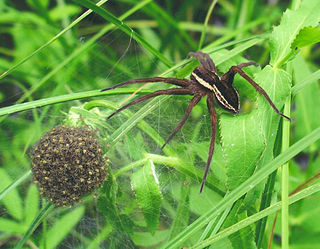
Dolomedes is a genus of large spiders of the family Pisauridae. They are also known as fishing spiders, raft spiders, dock spiders or wharf spiders. Almost all Dolomedes species are semiaquatic, with the exception of the tree-dwelling D. albineus of the southeastern United States. Many species have a striking pale stripe down each side of the body.

Xysticus is a genus of ground crab spiders described by C. L. Koch in 1835, belonging to the order Araneae, family Thomisidae. The genus name is derived from the Ancient Greek root xyst, meaning "scraped, scraper".
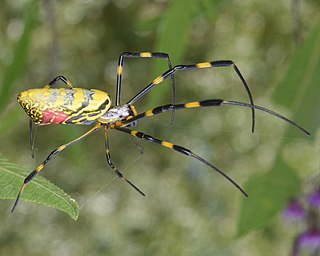
Trichonephila clavata, also known as the Joro-spider, is a spider in the Trichonephila genus. Native to East Asia, it is found throughout China, Japan, Korea, and Taiwan, and has been spreading across North America since the 2010s. It is venomous, but it rarely bites humans and its venom is not deadly.

Cheiracanthium, commonly called yellow sac spiders, is a genus of araneomorph spiders in the family Cheiracanthiidae, and was first described by Carl Ludwig Koch in 1839. They are usually pale in colour, and have an abdomen that can range from yellow to beige. Both sexes range in size from 5 to 10 millimetres. They are unique among common house spiders because their tarsi do not point either outward, like members of Tegenaria, or inward, like members of Araneus, making them easier to identify.
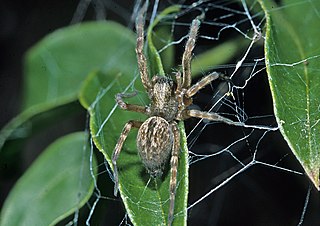
Badumna is a genus of intertidal spiders that was first described by Tamerlan Thorell in 1890. They are harmless spiders that can be found around human structures and buildings. The most well-known species is B. insignis, also known as the "black house spider" or "black window spider".
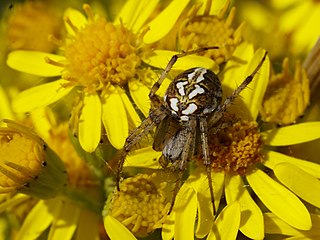
Neoscona, known as spotted orb-weavers and barn spiders, is a genus of orb-weaver spiders (Araneidae) first described by Eugène Simon in 1895 to separate these from other araneids in the now obsolete genus Epeira. The name Neoscona was derived from the Greek νέω, meaning "spin", and σχοῖνος, meaning "reed" They have a mostly pantropical distribution and one species, Neoscona adianta, has a palearctic distribution. As of April 2019 there are eight species that can be found in the United States and Canada:
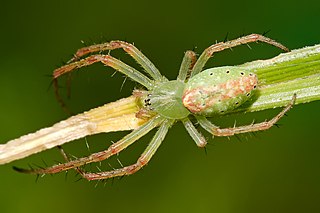
Cyrtophora, the tent-web spiders, is a genus of orb-weaver spiders first described by Eugène Simon in 1895. Although they are in the "orb weaver" family, they do not build orb webs. Their tent-like, highly complex non-sticky web is sometimes considered a precursor of the simplified orb web. These webs are aligned horizontally, with a network of supporting threads above them. These spiders often live in colonies. Females have a body length of mostly about 10 millimetres (0.39 in) long. Some members, including Cyrtophora cicatrosa, exhibit the ability to change colour rapidly.
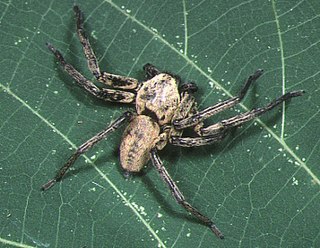
Thelcticopis is a genus of huntsman spiders that occurs almost exclusively in the area India to Japan to New Guinea and Fiji. However, one species occurs in Costa Rica, and another in Congo basin, although the latter species is probably misplaced in this genus.

Runcinia is a genus of crab spiders that was first described by Eugène Louis Simon in 1875. The former R. elongata is a synonym of Thomisus elongatus.

Heteropoda cervina, commonly called the brown huntsman, is a large species of spider in the family Sparassidae often found in leaf litter in central Queensland, Australia. The species was first described by Ludwig Carl Christian Koch in 1875 as Sarotes cervinus.

Isopeda is a genus of huntsman spiders that was first described by Ludwig Carl Christian Koch in 1875.

Desis is a genus of intertidal spiders that was first described by Charles Athanase Walckenaer in 1837. Species of the genus are found in Australasia, the Pacific, Japan, eastern and southern Africa, and India. They are marine spiders, living in the intertidal zone and only emerging at the ebb tide to hunt for invertebrates including shrimp. When submerged during high tides, they stay in an air chamber sealed with silk, and breathe its air.

Holothele is a genus of tarantulas that was first described by Ferdinand Anton Franz Karsch in 1879. Originally placed with the curtain-web spiders, it was transferred to the tarantulas in 1980.
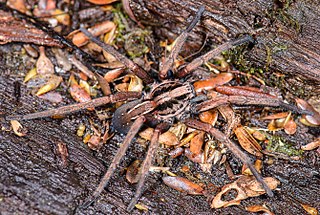
Miturga is a genus of spiders in the family Miturgidae. It was first described in 1870 by Thorell. As of 2024, it contains 15 species, all from Australia.
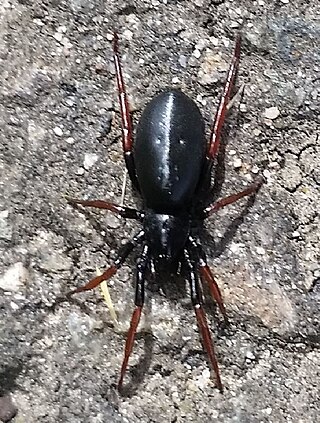
Trachyzelotes is a genus of ground spiders that was first described by H. Lohmander in 1944 as a subgenus of Zelotes, and was raised to genus status in 1967. It has a body length of 3 to 13 millimetres.
Marinarozelotes is a genus of ground spiders first described by A. V. Ponomarev and V. Y. Shmatko in 2020. The type species, Marinarozelotes barbatus, was originally described under the name "Melanophora barbata".



















